Petua & Cara Melebatkan Rambut: Rambut Sihat, Keyakinan Menyerlah 2025
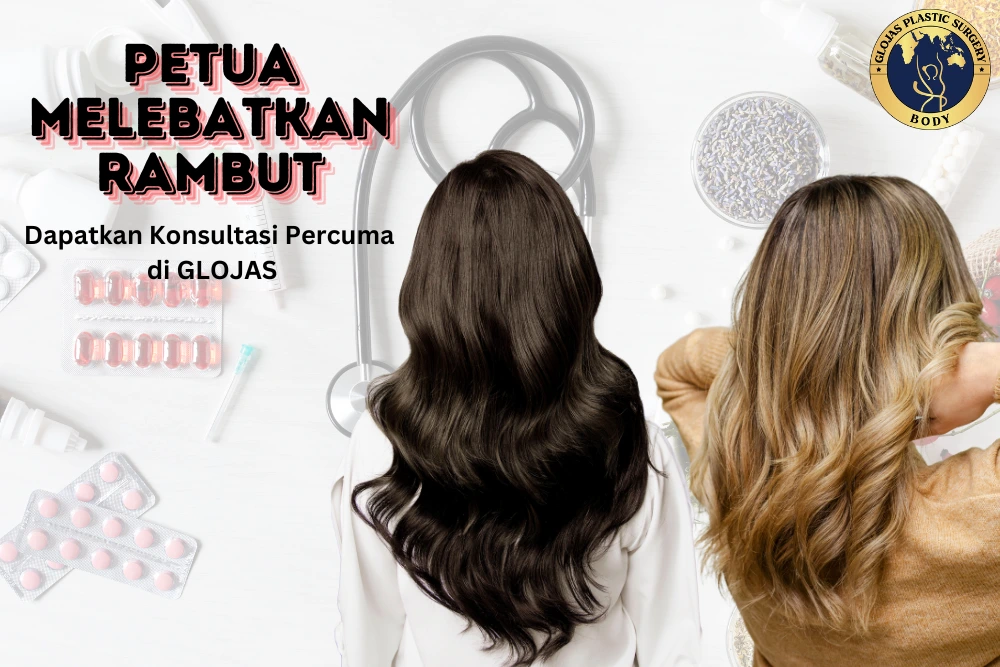
Melebatkan Rambut: Rahsia Rambut Lebat dan Sihat Rambut yang lebat dan sihat merupakan idaman ramai orang, terutamanya mereka yang menghadapi masalah rambut nipis atau keguguran rambut. Melebatkan rambut bukan sahaja meningkatkan keyakinan diri, tetapi juga menambah kecantikan semula jadi seseorang. Dalam artikel ini, kita akan mengupas beberapa cara yang berkesan untuk melebatkan rambut menggunakan bahan-bahan semula jadi serta amalan penjagaan rambut yang betul. Alamat : Glomac Galeria Hartamas, B-G, 05, Jalan 26a/70a, Desa Sri Hartamas, 50480 Wilayah Persekutuan, Wilayah Persekutuan Kuala Lumpur Dapatkan Arah Telefon : 012-989 1915 Laman Social : Facebook Youtube Instagram Punca Rambut Gugur Genetik Kebanyakan kes keguguran rambut pada lelaki adalah disebabkan oleh keadaan yang dikenali sebagai alopecia androgenetik, atau lebih dikenali sebagai kebotakan corak lelaki. Kondisi ini diwarisi dan dipengaruhi oleh hormon dihydrotestosterone (DHT). Perubahan Hormon Selain genetik, perubahan hormon juga boleh menyumbang kepada keguguran rambut. Hormon seperti testosteron boleh bertukar menjadi DHT yang mempunyai kesan mengecutkan folikel rambut sehingga rambut menjadi lebih nipis dan akhirnya gugur. Faktor Pemakanan Kekurangan zat makanan tertentu seperti protein, zat besi, dan vitamin B kompleks boleh menyebabkan rambut menjadi lemah dan mudah gugur. Tekanan Stres, sama ada fizikal atau emosi, boleh menyebabkan rambut masuk ke dalam fasa rehat lebih awal dari biasa yang kemudiannya mengakibatkan keguguran rambut. Penjagaan Rambut yang Tidak Sesuai Penggunaan bahan kimia keras, peralatan pemanas, dan teknik penjagaan rambut yang kasar juga boleh merosakkan rambut dan menyebabkan keguguran. Dapatkan Konsultasi Percuma Sekarang! Petua Melebatkan Rambut Pemakanan yang SeimbangPemakanan yang sihat dan seimbang memainkan peranan penting dalam kesihatan rambut. Pastikan diet harian anda kaya dengan protein, vitamin, dan mineral yang penting untuk pertumbuhan rambut. Makanan seperti telur, ikan, kacang, bayam, dan buah-buahan boleh membantu menguatkan akar rambut dan merangsang pertumbuhan rambut yang lebih lebat. Minyak Kelapa dan Minyak ZaitunMinyak kelapa dan minyak zaitun terkenal dengan khasiatnya dalam melebatkan rambut. Urutan minyak kelapa atau minyak zaitun ke kulit kepala dapat merangsang peredaran darah dan memberikan nutrisi kepada folikel rambut. Untuk hasil yang optimum, sapukan minyak pada kulit kepala dan rambut, biarkan selama sekurang-kurangnya 30 minit sebelum dibilas dengan syampu yang lembut. Aloe VeraAloe vera atau lidah buaya merupakan ramuan semula jadi yang sangat berkesan untuk pertumbuhan rambut. Gel aloe vera boleh digunakan sebagai masker rambut. Sapu gel aloe vera pada kulit kepala dan rambut, biarkan selama 30-45 minit, kemudian bilas dengan air suam. Penggunaan aloe vera secara berkala dapat membantu melebatkan rambut dan memberikan kilauan semula jadi. Penggunaan Syampu dan Perapi yang SesuaiPemilihan syampu dan perapi yang sesuai dengan jenis rambut juga penting dalam usaha melebatkan rambut. Elakkan produk yang mengandungi bahan kimia keras yang boleh merosakkan rambut. Pilih produk yang diformulasikan khusus untuk rambut nipis dan mengandungi bahan semula jadi yang dapat membantu melebatkan rambut. Amalan Urutan Kulit Kepala.Urutan kulit kepala secara berkala dapat membantu merangsang folikel rambut dan meningkatkan pertumbuhan rambut. Gunakan jari-jari anda untuk mengurut kulit kepala dengan lembut dalam gerakan bulat selama 5-10 minit setiap hari. Amalan ini bukan sahaja membantu melebatkan rambut, tetapi juga mengurangkan tekanan dan meningkatkan kesihatan kulit kepala. Mengelakkan Penggunaan Alat Penggayaan PanasPenggunaan alat penggayaan rambut yang panas seperti pengering rambut, pelurus, dan pengeriting boleh merosakkan rambut dan menyebabkan rambut menjadi nipis. Kurangkan penggunaan alat-alat ini dan biarkan rambut kering secara semula jadi sebanyak mungkin. Jika perlu menggunakan alat penggayaan, pastikan menggunakan pelindung haba untuk melindungi rambut dari kerosakan. Gaya Hidup SihatGaya hidup yang sihat seperti mengurangkan tekanan, mendapat tidur yang cukup, dan bersenam secara berkala juga menyumbang kepada kesihatan rambut. Tekanan yang berlebihan boleh menyebabkan keguguran rambut, jadi penting untuk mengamalkan teknik relaksasi seperti meditasi atau yoga. Dapatkan Konsultasi Percuma Sekarang! Pakar Tanam Rambut di GLOJAS View this post on Instagram A post shared by GLOJAS HAIR TRANSPLANT SPECIALIST MALAYSIA (@fuehairtransplantmalaysia) Melebatkan rambut memerlukan kesabaran dan konsistensi dalam penjagaan rambut. Dengan mengamalkan tips-tips di atas, anda boleh mendapatkan rambut yang lebat, sihat, dan berkilau secara semula jadi. Ingatlah bahawa rambut yang sihat bermula dari dalam, jadi pastikan anda menjaga kesihatan dalaman untuk mencapai rambut yang diidamkan. Dapatkan Konsultasi Percuma Sekarang! BACA ARTIKEL : Manfaat Pembedahan Transplantasi Rambut Facebook Twitter LinkedIn Pinterest Reddit WhatsApp
Penyakit Kulit Kepala – Dapatkan Rawatan di GLOJAS
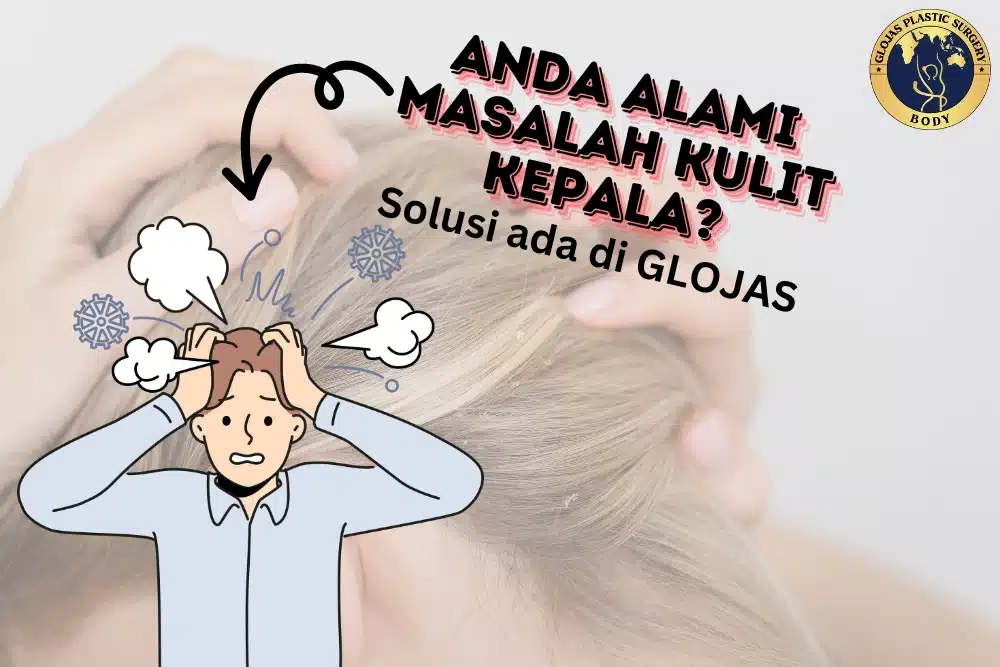
Apa itu Penyakit Kulit Kepala Penyakit kulit kepala adalah masalah kesihatan yang biasa dialami oleh ramai individu. Kulit kepala yang sihat adalah penting untuk pertumbuhan rambut yang baik dan keselesaan keseluruhan. Berikut adalah beberapa jenis penyakit kulit kepala yang sering terjadi, punca, gejala, dan cara rawatannya. Alamat : Glomac Galeria Hartamas, B-G, 05, Jalan 26a/70a, Desa Sri Hartamas, 50480 Wilayah Persekutuan, Wilayah Persekutuan Kuala Lumpur Dapatkan Arah Telefon : 012-989 1915 Laman Social : Facebook Youtube Instagram Jenis-Jenis Penyakit Kulit Kepala Kelemumur Punca: Dihasilkan oleh kulat Malassezia yang tumbuh pada kulit kepala berminyak. Faktor lain termasuk tekanan, cuaca sejuk, dan diet tidak seimbang.Gejala: Kulit kepala yang bersisik, gatal, dan berwarna merah. Kepingan kulit mati yang putih atau kuning sering kali kelihatan di rambut dan pakaian. Psoriasis Kulit KepalaPunca: Penyakit autoimun yang menyebabkan sel kulit membiak dengan cepat sehingga membentuk plak tebal.Gejala: Plak merah yang tebal dan bersisik putih perak. Kulit kepala sering gatal dan kering. Kulat Kulit Kepala Punca: Jangkitan kulat dermatofit yang mudah merebak melalui sentuhan langsung atau barang yang tercemar.Gejala: Tompok bersisik yang gatal dan kemerahan, keguguran rambut di kawasan yang terjejas, dan kadang-kala keradangan serta lepuhan. FolikulitisPunca: Jangkitan bakteria, kulat, atau virus yang menyebabkan keradangan pada folikel rambut. Ia juga boleh disebabkan oleh iritasi akibat bercukur atau produk rambut.Gejala: Benjolan merah kecil atau pustula yang gatal dan menyakitkan. Kadang-kadang, ia boleh berisi nanah. Dapatkan Konsultasi Percuma Sekarang! Pencegahan Penyakit Kulit Kepala Kebersihan yang Baik: Cuci rambut secara berkala dengan syampu yang sesuai untuk jenis rambut dan kulit kepala. Elakkan penggunaan produk rambut yang keras dan mengandungi banyak bahan kimia. Diet Seimbang: Pengambilan makanan yang kaya dengan vitamin dan mineral boleh membantu mengekalkan kesihatan kulit kepala. Pengurusan Tekanan: Tekanan boleh mempengaruhi kesihatan kulit kepala. Amalkan teknik pengurusan tekanan seperti yoga, meditasi, dan senaman. Elakkan Sentuhan Terus: Jangan berkongsi barang peribadi seperti sikat, tuala, dan topi untuk mengelakkan penyebaran penyakit berjangkit. Dapatkan Konsultasi Percuma Sekarang! Pakar Tanam Rambut di GLOJAS View this post on Instagram A post shared by GLOJAS HAIR TRANSPLANT SPECIALIST MALAYSIA (@fuehairtransplantmalaysia) Penyakit kulit kepala adalah masalah yang biasa, tetapi dengan pemahaman yang baik tentang punca, gejala, dan rawatan yang betul, ia boleh diurus dengan berkesan. Jika mengalami gejala yang tidak sembuh dengan rawatan sendiri, adalah penting untuk mendapatkan nasihat daripada pakar dermatologi untuk rawatan yang lebih spesifik dan berkesan. Dengan penjagaan yang betul, kulit kepala yang sihat dapat dikekalkan, seterusnya menyumbang kepada kesihatan rambut yang baik. Dapatkan Konsultasi Percuma Sekarang! BACA ARTIKEL : Perubatan Selepas Transplantasi Rambut Facebook Twitter LinkedIn Pinterest Reddit WhatsApp
Hair Graft Price Calculator Malaysia | Hair Transplant Costs
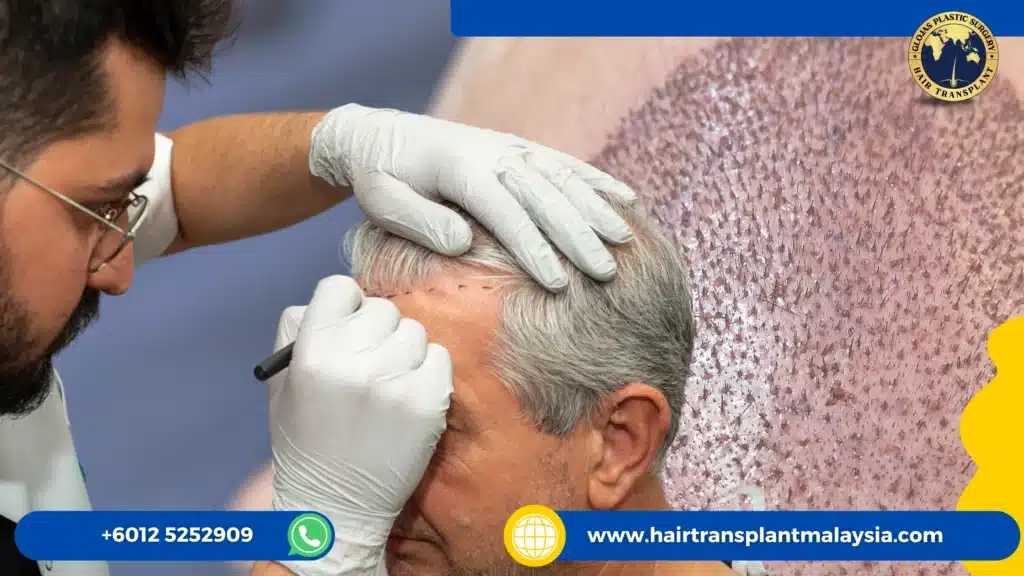
Welcome to our Hair Graft Price Calculator for Malaysia, your ultimate resource for estimating the cost of your FUE hair transplant clinic. Understanding the costs involved is crucial in planning your journey to a fuller head of hair. Use our calculator to get a precise estimate based on the number of grafts you need. Explore our detailed graft and price list below to get started. Calculate the average graft according to your hair loss: 1 – 100 to 500 grafts 2 – 800 to 1200 grafts 3 – 500 to 800 grafts 4 – 1800 to 2000 grafts 5 – 800 to 1000 grafts 6 – 500 to 800 grafts 7 – 500 to 700 grafts From the graft calculated, find the estimated price range: Hair Graft Price Calculator Malaysia Our pricing is transparent and competitive, designed to help you achieve your desired results within your budget. Below is a detailed breakdown of the cost per graft. Number of Grafts Price per Graft (MYR) Total Price (MYR) 500 10 5,000 1,000 9 9,000 1,500 8 12,000 2,000 7 14,000 2,500 6.5 16,250 3,000 6 18,000 3,500 5.5 19,250 4,000 5 20,000 4,500 4.75 21,375 5,000 4.5 22,500 Why Choose Us? – Hair Graft Price Experienced Specialists: Our team comprises highly skilled surgeons with extensive experience in hair transplant procedures. Advanced Techniques: We utilize the latest techniques and technologies to ensure the best possible outcomes. Personalized Care: Each treatment plan is tailored to meet the unique needs of our clients. Transparent Pricing: No hidden fees; the price you see is the price you pay. Frequently Asked Questions: Hair Graft Price Calculator Malaysia 1. How do I know how many grafts I need? Consult with our hair transplant specialists for an assessment. They will help you determine the exact number of grafts required based on your hair loss pattern. 2. Are there any additional costs? Our quoted prices include all standard costs associated with the procedure. Additional fees may apply for special requirements or additional services, which will be discussed during your consultation. 3. How long does the procedure take? The duration of the procedure depends on the number of grafts needed. Most procedures are completed within one day. 4. What is the recovery time? Recovery time varies, but most patients can resume normal activities within a week. Full recovery and hair growth results are typically seen within 6 to 12 months. Conclusion For an accurate quote tailored to your unique situation, we recommend scheduling a consultation with our specialists. Get a free consultation at Glojas and get the exact price for your hair transplant surgery. Disclaimer: Please note that the prices provided above are average estimates and may vary for each individual based on specific needs and circumstances. The exact cost can differ due to factors such as the complexity of the procedure, the number of grafts required, and any additional treatments or services. For an accurate quote tailored to your unique situation, we recommend scheduling a consultation with our specialists.
FUE Hair Transplant Before and After
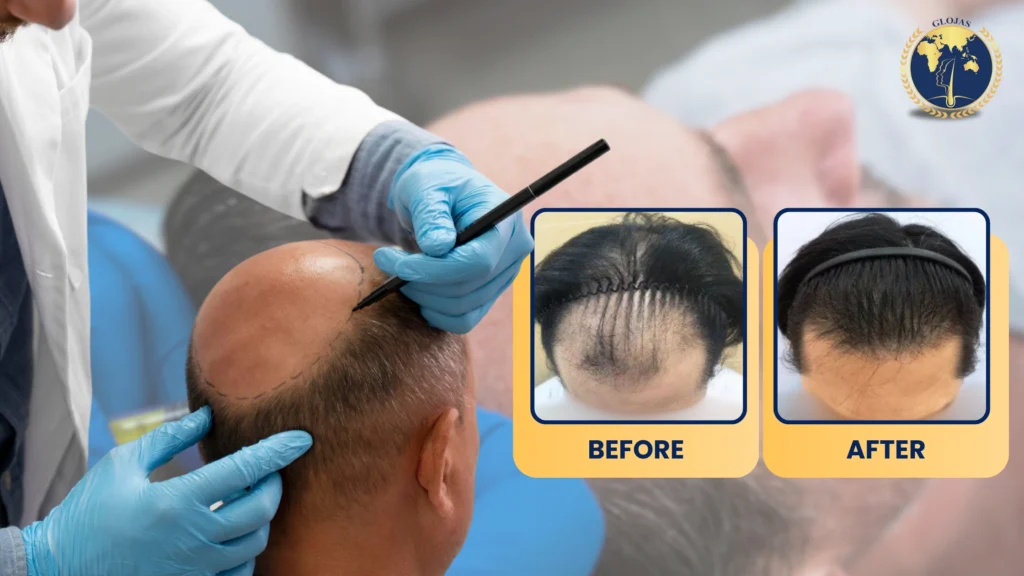
Hair loss is a common concern for many, affecting both men and women of various ages. One of the most effective and popular solutions to combat this issue is the Follicular Unit Extraction (FUE) hair transplant. This article delves into the effects of FUE hair transplant before and after, showcasing the remarkable before and after results that can restore not just hair, but confidence and self-esteem. What is FUE Hair Transplant? FUE hair transplant, or Follicular Unit Extraction, is a cutting-edge hair restoration technique that involves the individual removal of hair follicles from a donor area, typically the back or sides of the head. These follicles are then meticulously implanted one by one into the thinning or balding areas of the scalp. This method is favored for its precision and natural-looking results, as well as the fact that it leaves minimal scarring compared to older transplantation methods. One of the major advantages of FUE is the ability to wear short haircuts post-transplant without noticeable scarring. The Process of FUE Hair Transplant Consultation and Planning The journey to a fuller head of hair begins with an in-depth consultation at a renowned clinic like Hills Hair Group. During this initial stage, experts assess the patient’s hair loss pattern, discuss expectations, and plan the number of follicular unit grafts required. This step is crucial as it helps tailor a personal treatment plan that aligns with the patient’s hair restoration goals. Extraction of Hair Follicles The next step involves the extraction of hair follicles directly from the scalp. This is a meticulous process where individual follicular units are removed one by one using a specialized tool. Unlike traditional methods, FUE leaves no linear scars and allows for faster recovery. Each graft is carefully preserved until it can be transplanted to the thinning or bald areas. Implantation After extraction, the grafts are implanted in the recipient areas that have been mapped out during the planning phase. Tiny incisions are made in these areas, and the follicular units are placed carefully to match the natural growth pattern of the hair. This stage is critical for achieving a natural-looking and densely packed result. FUE Hair Transplant: Before and After Before the Procedure Before undergoing an FUE hair transplant, many patients experience significant hair thinning or bald patches that can affect their self-confidence. The areas often targeted include the hairline, crown, and sometimes the mid-scalp. These issues are documented through photos and consultations to create a clear plan for addressing each area effectively during the transplant. After the Procedure Post-transplant, the results unfold over several months. Initially, the transplanted hair will shed—a normal part of the process. After this shedding phase, new growth begins, usually around three to four months post-procedure. By the ninth month, most patients observe considerable improvements in density and coverage. The transformations can be astonishing, with before and after photos showing dramatic restoration of hair that looks natural and seamless. Real-Life Transformations – Celebrity Celebrities often lead the charge when it comes to cosmetically enhancing their appearance, including hair transplants. Their transformations can shine a spotlight on the effectiveness of these procedures, specifically Follicular Unit Extraction (FUE). Let’s delve into a couple of famous cases that have made headlines. Where did Elon Musk get his hair transplant? Elon Musk, the dynamic entrepreneur behind Tesla and SpaceX, also appears to have had a hair transplant, although details about where and when are less publicized. Judging by before-and-after comparisons, Musk’s hairline and the density of his hair have dramatically improved. Industry experts speculate that he may have opted for an advanced FUE transplant, given the natural and unnoticeable outcome evident in his public appearances. Benefits of FUE Hair Transplant FUE hair transplants offer multiple benefits that make the procedure highly recommendable. This technique of hair restoration involves taking individual hair follicles from a donor area and implanting them where hair is thinning. It’s famed not only for its effectiveness but also for the minimal downtime and lack of significant scarring. Here are some of the key advantages: Minimally Invasive: Unlike traditional strip harvesting, FUE is less invasive with no scalpel incision or stitches, which significantly reduces the recovery time. Natural Looking Results: The careful placement of grafts in the natural direction of hair growth ensures results that blend seamlessly with your existing hair. Flexibility for Hair Styles: FUE typically leaves minimal scarring, allowing most patients to wear their hair at very short lengths without noticeable scars. Effective for Varying Hair Loss: Suitable for patients with different hair loss stages whether it’s just beginning or at an advanced stage, making it a versatile option for many. These benefits contribute significantly to the popularity of the FUE technique, especially among those who wish to recover swiftly without compromising daily activities. Conclusion FUE hair transplant offers a significant opportunity for individuals experiencing hair loss to regain not just their strands but also their confidence. After witnessing countless before and after transformations, it’s clear that this method can produce impressive and life-changing results. Whether addressing bald patches or a receding hairline, FUE provides a refined approach that integrates seamlessly with your existing hair, enhancing your overall appearance. If considering a hair restoration solution, FUE should certainly be on your list. With a high success rate and minimal downtime, it’s a pathway back to thick, natural-looking hair. If you are struggling with hair loss, schedule a consultation at GLOJAS Clinic. Their team of professionals will organize a thorough evaluation and deliberate the most effective treatment alternatives to obtain your desired outcome. Don’t let hair loss hold you lower back. Contact GLOJAS Clinic these days and take the first step towards a more healthy, happier you!
Hair Transplant Journey: Travel with Us!

Planning Your Hair Transplant Journey Choosing the Right Clinic Embarking on a hair transplant journey begins with selecting the right hair transplant clinic. Research various clinics, paying close attention to their reputation, reviews, and the expertise of their hair transplant specialists. Clinics like Glojas, renowned for their SMART™ FUE hair transplant procedure, often have a proven track record of successful hair transplant surgeries. Researching Hair Transplant Options Understanding the different hair transplant options is crucial. The most common procedures include FUT (Follicular Unit Transplantation) and FUE (Follicular Unit Extraction). Research each method’s benefits, risks, and recovery timeline to determine which is best suited for your hair loss pattern and lifestyle. Setting a Budget Budgeting is an essential part of planning your hair transplant. Hair transplant cost can vary significantly based on the clinic, location, and extent of the procedure. Be sure to consider additional expenses such as travel, accommodation, and post-op care products. Hair Transplant Surgery Consultation with the Hair Transplant Specialist A thorough consultation with your chosen hair transplant surgeon is vital. During this meeting, discuss your hair loss history, desired outcomes, and any concerns you may have. The specialist will evaluate your scalp and hair follicles to create a personalized hair transplant plan. Pre-Op Instructions Adhering to pre-op instructions is crucial for a successful hair transplant surgery. Your specialist will likely advise you to avoid certain medications, alcohol, and smoking. Following these guidelines helps minimize potential complications in hair transplantation during and after the transplant. Packing Essentials for the Trip If you’re traveling for your hair transplant, pack essentials such as comfortable clothing, prescribed medications, and any necessary documentation. Preparing ahead of time ensures a smooth and stress-free journey to the hair transplant clinic. Arriving at Your Destination Travel Tips for a Smooth Journey Ensure you have all travel arrangements sorted, including transportation to and from the airport. Staying relaxed and hydrated during your journey can help you arrive at your hair transplant clinic in optimal condition. Check-In at the Clinic Upon arrival at the clinic, you’ll check in and fill out any necessary paperwork. This step includes confirming your personal details and the specifics of your hair transplant procedure. Meeting the Medical Team Meeting the medical team helps build confidence and comfort. The team will explain the hair transplant timeline, the steps involved, and answer any last-minute questions you might have about the procedure. Understanding the Hair Transplant Procedure Explanation of the Process The hair transplant procedure begins with the extraction of hair grafts from the donor area. These hair grafts are then meticulously implanted into the thinning or balding areas of your scalp. Clinics like Glojas use the SMART™ FUE technique for precise and natural-looking results. Anaesthesia and Pain Management Local anesthesia is administered to ensure a pain-free experience during the hair transplant surgery. Post-surgery, your doctor will prescribe pain management medications to address any discomfort you might experience during the initial recovery days. Duration of the Surgery The duration of a hair transplant surgery can vary depending on the number of grafts being transplanted. Usually, the process takes around 4 to 8 hours. You can unwind and may even enjoy a film or some music. hair transplant treatment shaving hair restoration surgery hair thinning Recovery Period Following your hair transplant, you’ll receive detailed post-op care instructions. These will include guidelines on washing your hair, avoiding direct sunlight, and not engaging in strenuous activities for a specified period to ensure optimal recovery. Mild discomfort and swelling are common after a hair transplant. Applying prescribed medications and cold compresses can help alleviate these symptoms. It’s essential to follow your surgeon’s advice to manage any side effects effectively. Hair growth after a hair transplant follows a specific timeline. Initially, transplanted hair may shed, which is normal. New hair growth typically starts within a few months and continues to improve over the year. Keeping a hair transplant growth chart can help track your progress. # ol dudley # hair transplant treatment # hair restoration surgery # hair thinning Hair Transplant Recovery Timeline Understanding the hair transplant recovery timeline is crucial for setting realistic expectations. The first seven days after hair transplant surgery involve the most significant healing and require careful attention to post-op care instructions. During this period, you might experience mild redness and swelling. In the first week, it’s essential to avoid activities that might disrupt the transplanted grafts. By the end of the second week, the transplanted areas begin to heal, and the initial shedding of transplanted hair follicles starts. This shedding is a natural part of the hair growth cycle and is known as shock hair loss. Hair regrowth will commence a few months post-surgery, with noticeable results around the six-month mark. Full results typically manifest within 12 to 18 months, showcasing a successful hair transplant operation. Hair Transplant Timeline Initial Days After Hair Transplant The days after hair transplant surgery are critical for the recovery process. The first week demands strict adherence to post-op care, avoiding any activities that could damage the transplanted grafts. During these initial days, patients often experience mild redness and minimal hair loss in the transplanted areas. Hair Growth Timeline The hair growth timeline after a hair transplant varies among individuals. Generally, new hair starts to grow within three to four months, following the initial shock hair loss. This period marks the beginning of the hair growth cycle, where transplanted hair follicles enter the anagen phase, leading to continuous hair regrowth. Full results are usually visible within 12 to 18 months post-surgery. Exploring the Local Area While you’re recovering, take the opportunity to explore the local area. Many hair transplant clinics are located in cities with rich cultural and recreational offerings. Light sightseeing can be a pleasant distraction during your recovery days. Enjoying local cuisine is another way to enhance your trip. Be mindful of your diet, especially in the immediate post-op period, but don’t miss out on experiencing new flavors and dishes. Engage in
Before Hair Transplant: Essential Things You Need to Know
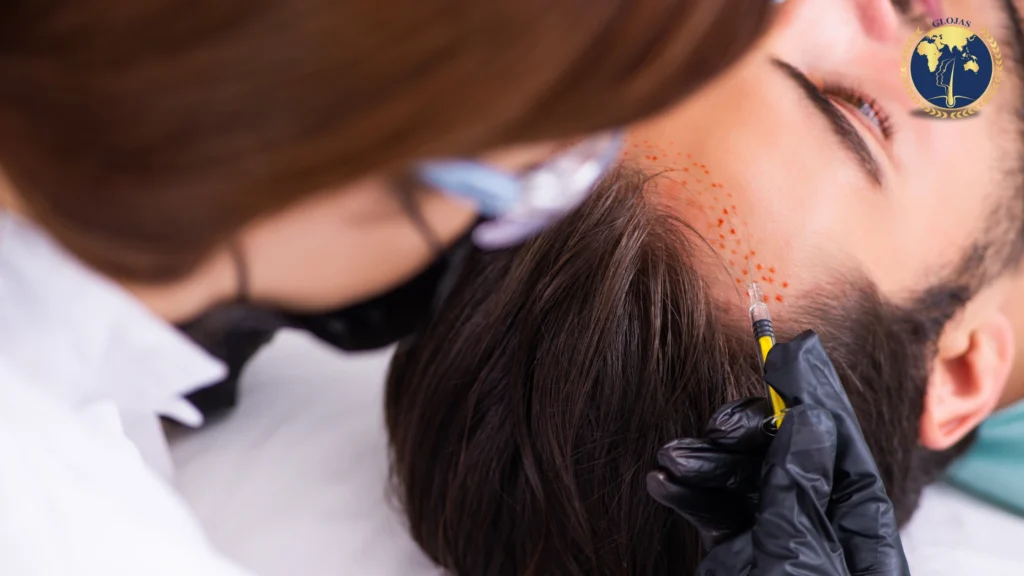
Deciding to undergo a hair transplant can be a game-changer in reclaiming your hairline and self-confidence. Whether you’re dealing with male pattern baldness, thinning hair, or significant hair loss, this surgical technique can offer a permanent solution to hair restoration. Before hair transplant journey, understanding the important steps and preparations needed for a successful procedure is crucial. This guide will walk you through necessary precautions, preparations, and considerations to ensure you are fully ready for your hair transplant surgery. From selecting the right medical practitioner to understanding the nature of your intended hair results, we’ll cover all you need to get started on this transformative path. Understanding Hair Transplant – Before Hair Transplant What is a Hair Transplant? A hair transplant is a medical procedure that involves moving hair follicles from one part of the body, known as the donor site, to a bald or balding part of the body, known as the recipient site. Primarily used to treat male pattern baldness, this surgery can also remedy hair loss due to scars, trauma, or diseases affecting hair growth. Techniques may differ, but the most common methods include Follicular Unit Transplantation (FUT) and Follicular Unit Extraction (FUE), both of which offer permanent solutions to hair loss by transferring your own hair. Who is a Good Candidate? Ideal candidates for hair transplant surgery are those who have stable hair loss. Men with male pattern baldness, women with female pattern baldness, or individuals who have lost hair due to an injury are often suitable candidates. Importantly, candidates should have enough healthy hair follicles available for transplantation. Patients are typically expected to be in good general health, as potential risks and recovery are closely tied to overall wellness. Understanding that results vary and having realistic expectations are essential psychological factors to consider before proceeding. Researching Your Options – Before Hair Transplant Choosing the Right Clinic Selecting a clinic for your hair transplant is a crucial step in your journey to hair restoration. Look for clinics that specialize in hair transplantation with a proven track record of success. Ensure that the facility is licensed and adheres to standard health and safety protocols. The clinic’s technological advancement is also important, as more modern equipment can lead to more precise and less invasive procedures. Selecting a Qualified Surgeon The surgeon’s expertise is arguably the most critical factor in the success of your hair transplant. Confirm that the surgeon has specific training and substantial experience in performing hair transplant surgeries. Certifications by relevant medical boards and memberships in professional bodies such as the International Society of Hair Restoration Surgery can serve as indicators of a surgeon’s proficiency and ethical standards. Reading Reviews and Testimonials Gather insights from former patients to understand their experiences with the clinic and the surgeon. Reading reviews and testimonials can provide you with practical information about the effectiveness of the procedures offered, the professionalism of the staff, and the overall satisfaction levels of past clients. While positive reviews can affirm your choices, critical reviews can help you steer clear of potential shortcomings and make an informed decision. Consultations – Before Hair Transplant Initial Consultation: What to Expect During your initial hair transplant consultation, expect a thorough assessment of your scalp and hair loss condition. The medical practitioner will evaluate factors such as hair density, hair quality, and scalp laxity. They will also discuss your medical history to determine if you are a suitable candidate for hair transplant surgery. This session aims to set realistic expectations for the surgery’s outcome based on your specific situation. You can also anticipate receiving detailed explanations about the different transplant techniques, such as FUE (Follicular Unit Extraction) and FUT (Follicular Unit Transplantation). Questions to Ask Your Surgeon Preparing questions before your consultation can immensely benefit your understanding and comfort level before undergoing hair transplant surgery. Key questions to consider include: – What type of hair transplant technique is most suitable for me? – How many sessions are needed to achieve the desired result? – What should I expect during the recovery process? – Are there any potential risks or complications associated with the surgery? – Can you show me before and after photos of previous patients with similar hair loss as mine? Celebrity and Hair Transplant Elon Musk’s Experience with Hair Growth Elon Musk, the entrepreneur behind Tesla and SpaceX, has been widely speculated to have undergone some form of hair restoration treatment. From visibly thinning hair in early photos to a fuller hairline in more recent times, Musk’s hair transformation has been impressive and motivating for many looking into hair transplant options. His journey underscores the importance of selecting skilled, experienced surgeons and illustrates how technological advancements can lead to natural-looking hair transplant results. Conclusion Preparing for a hair transplant is a crucial step towards ensuring the success of your procedure. It’s important to follow all the guidelines provided by your medical practitioner, maintain a healthy lifestyle, and set realistic expectations. Remember, the better your preparation, the smoother the process and the better the outcomes. Pay close attention to pre-surgery instructions, engage in conversations with your surgeon to address any concerns, and get ready to welcome the new changes with confidence. Hair transplantation is a viable choice for people hoping to reestablish their hair and recapture their confidence. By grasping the various sorts of procedures, candidacy, preparation, and recovery processes, patients can make an educated decision about whether hair transplantation is appropriate for them. Consulting with a certified professional is fundamental to examine individual requirements and expectations and foster a customized treatment plan.
Mikropigmentasi Kulit Kepala| Rambut Lebat, Keyakinan Hebat
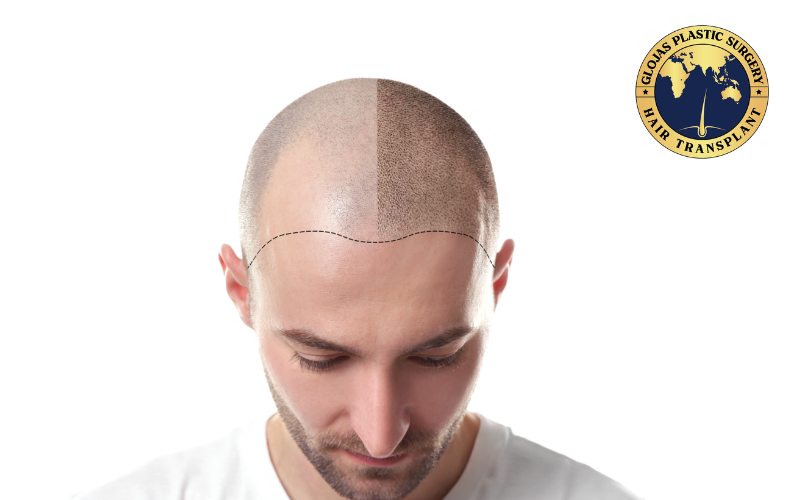
Mikropigmentasi Kulit Kepala: Penyelesaian Moden untuk Rambut Gugur Mikropigmentasi kulit kepala (Scalp Micropigmentation atau SMP) adalah teknik kosmetik moden yang semakin popular di kalangan individu yang mengalami masalah rambut gugur atau penipisan rambut. Prosedur ini menawarkan penyelesaian yang semulajadi dan berkesan, memberikan penampilan kepala yang berambut lebat tanpa perlu menjalani pembedahan atau menggunakan produk rambut yang mahal. Alamat : Glomac Galeria Hartamas, B-G, 05, Jalan 26a/70a, Desa Sri Hartamas, 50480 Wilayah Persekutuan, Wilayah Persekutuan Kuala Lumpur Dapatkan Arah Telefon : 012-989 1915 Laman Social : Facebook Youtube Instagram Apa itu Mikropigmentasi Kulit Kepala? Mikropigmentasi kulit kepala adalah proses di mana pigmen khas disuntik ke dalam lapisan dermis kulit kepala menggunakan jarum mikro. Teknik ini menghasilkan ilusi rambut yang tumbuh rapat di kulit kepala, menyerupai penampilan rambut asli yang dipotong pendek. Pigmen yang digunakan adalah hypoallergenic dan direka untuk meniru warna rambut asli seseorang. Kelebihan Mikropigmentasi Kulit Kepala Penampilan Semulajadi:Mikropigmentasi memberikan ilusi rambut yang sangat realistik. Ia boleh disesuaikan dengan warna kulit dan rambut individu untuk memastikan hasil yang semulajadi. Tidak Invasif:Berbanding dengan pembedahan pemindahan rambut, SMP adalah prosedur yang tidak invasif dan tidak memerlukan masa pemulihan yang lama. Kos yang Jimat:SMP biasanya lebih murah berbanding pembedahan tanam rambut dan tidak memerlukan rawatan susulan yang mahal. Kesan Serta-merta: Hasil mikropigmentasi kulit kepala dapat dilihat segera selepas sesi rawatan. Ia juga memerlukan penyelenggaraan yang minimum. Dapatkan Konsultasi Percuma Sekarang! Prosedur Mikropigmentasi Proses mikropigmentasi biasanya melibatkan beberapa sesi, bergantung kepada keluasan kawasan yang dirawat dan ketebalan ilusi rambut yang diinginkan. Setiap sesi boleh mengambil masa beberapa jam. Berikut adalah langkah-langkah umum dalam prosedur SMP: Konsultasi Awal: Pakar SMP akan menilai keadaan kulit kepala dan rambut anda, membincangkan hasil yang diinginkan, dan menjelaskan proses rawatan. Reka Bentuk Garisan Rambut: Garis rambut yang sesuai akan direka berdasarkan bentuk wajah dan gaya pilihan anda. Proses Pigmentasi: Pigmen akan disuntik ke dalam kulit kepala menggunakan jarum mikro. Proses ini dilakukan dengan teliti untuk memastikan setiap titik pigmen menyerupai folikel rambut semulajadi. Penjagaan Selepas Rawatan: Anda akan diberikan panduan penjagaan selepas rawatan untuk memastikan hasil yang terbaik dan mengelakkan sebarang komplikasi. Siapa yang Sesuai untuk Mikropigmentasi Kulit Kepala? Mikropigmentasi kulit kepala sesuai untuk individu yang mengalami pelbagai masalah rambut seperti: Kebotakan corak lelaki atau wanita Rambut nipis atau jarang Pesakit alopecia Dapatkan Konsultasi Percuma Sekarang! Pakar Penanaman Rambut di GLOJAS View this post on Instagram A post shared by GLOJAS HAIR TRANSPLANT SPECIALIST MALAYSIA (@fuehairtransplantmalaysia) Mikropigmentasi kulit kepala adalah pilihan yang menarik bagi mereka yang mencari penyelesaian yang semulajadi dan tidak invasif untuk masalah rambut gugur. Dengan perkembangan teknologi dan teknik yang semakin canggih, SMP menawarkan hasil yang sangat memuaskan dan tahan lama. Jika anda menghadapi masalah rambut gugur, pertimbangkan mikropigmentasi kulit kepala sebagai alternatif yang efektif dan praktikal untuk meningkatkan penampilan dan keyakinan diri anda. Dapatkan Konsultasi Percuma Sekarang! BACA ARTIKEL : Penyelesaian Pemulihan Rambut Facebook Twitter LinkedIn Pinterest Reddit WhatsApp
Transplantasi Folikel Rambut | Pakar Rambut #1 di GLOJAS
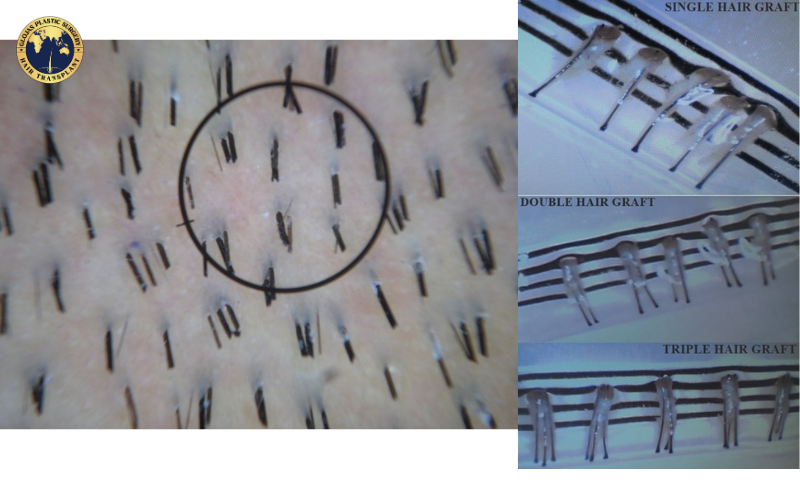
Transplantasi Folikel Rambut: Penyelesaian Moden untuk Masalah Keguguran Rambut Keguguran rambut adalah masalah yang dihadapi oleh ramai individu, tanpa mengira usia atau jantina. Faktor genetik, hormon, gaya hidup, dan tekanan boleh menyumbang kepada masalah ini. Salah satu penyelesaian moden yang semakin popular untuk atasi keguguran rambut adalah transplantasi folikel rambut. Alamat : Glomac Galeria Hartamas, B-G, 05, Jalan 26a/70a, Desa Sri Hartamas, 50480 Wilayah Persekutuan, Wilayah Persekutuan Kuala Lumpur Dapatkan Arah Telefon : 012-989 1915 Laman Social : Facebook Youtube Instagram Apa Itu Transplantasi Folikel Rambut? Transplantasi folikel rambut adalah prosedur perubatan di mana folikel rambut dari bahagian tubuh yang kaya dengan rambut, seperti belakang kepala, dipindahkan ke kawasan yang mengalami kebotakan atau penipisan rambut. Terdapat dua teknik utama yang sering digunakan dalam prosedur ini: Follicular Unit Transplantation (FUT): Dalam teknik ini, sekeping kulit dari kawasan penderma diambil dan folikel rambut dipisahkan secara individu sebelum ditanam semula di kawasan yang memerlukan. Follicular Unit Extraction (FUE): Teknik ini melibatkan pengambilan folikel rambut secara individu terus dari kawasan penderma dan kemudian ditanam semula. FUE dianggap kurang invasif berbanding FUT kerana tidak melibatkan pembedahan besar atau jahitan. Dapatkan Konsultasi Percuma Sekarang! Proses Transplantasi Langkah 1 Pakar kami akan memilih kawasan penderma (Donor area) dengan teliti dan menyediakan kawasan untuk pengeluaran grafts Langkah 2 Grafts ini akan dikeluarkan dengan tepat dan selamat menggunakan peranti SMART™ yang hanya tersedia di klinik kami Langkah 3 Grafts akan disusun dan diubah suai untuk dipadankan dengan rambut sedia ada untuk mendapatkan hasil yang asli Langkah 4 Grafts ini akan ditanam pada kawasan rambut gugur dengan tepat untuk mencapai sudut, penempatan dan ketumpatan yang betul. Grafts yang ditanam akan nampak sebati dengan rambut sedia ada untuk membolehkan hasil yang asli Dapatkan Konsultasi Percuma Sekarang! Kelebihan Transplantasi Folikel Rambut Penampilan Semula Jadi: Dengan teknologi terkini, hasil transplantasi folikel rambut kelihatan sangat semula jadi. Folikel rambut yang ditanam akan tumbuh seperti rambut asli. Kepuasan Diri dan Keyakinan: Rambut yang sihat dan penuh boleh meningkatkan keyakinan diri dan imej diri seseorang. Hasil yang Kekal: Transplantasi folikel rambut menawarkan penyelesaian yang lebih kekal berbanding rawatan semulajadi atau ubat-ubatan yang hanya memberikan hasil sementara. Dapatkan Konsultasi Percuma Sekarang! Pakar Penanaman Rambut di GLOJAS View this post on Instagram A post shared by GLOJAS HAIR TRANSPLANT SPECIALIST MALAYSIA (@fuehairtransplantmalaysia) Transplantasi folikel rambut adalah solusi efektif bagi mereka yang mengalami masalah keguguran rambut. Dengan kemajuan teknologi dan kaedah pembedahan yang semakin canggih, prosedur ini bukan sahaja memberikan hasil yang semula jadi tetapi juga meningkatkan kualiti hidup pesakit. Bagi sesiapa yang mempertimbangkan untuk menjalani transplantasi folikel rambut, adalah penting untuk mendapatkan nasihat daripada pakar rambut yang berpengalaman dan menjalani konsultasi yang teliti untuk memastikan keputusan yang terbaik.Di glojas, kumpulan pakar kami yang diketuai oleh Professor Dato` Dr JasG yang telah berpengalaman dan kemahiran lebih dari 26 tahun akan memastikan pelanggan kami berpuas hati. Dapatkan Konsultasi Percuma Sekarang! BACA ARTIKEL : Penyelesaian Pemulihan Rambut Facebook Twitter LinkedIn Pinterest Reddit WhatsApp
Transform Your Look with Hair Transplant Hairstyle
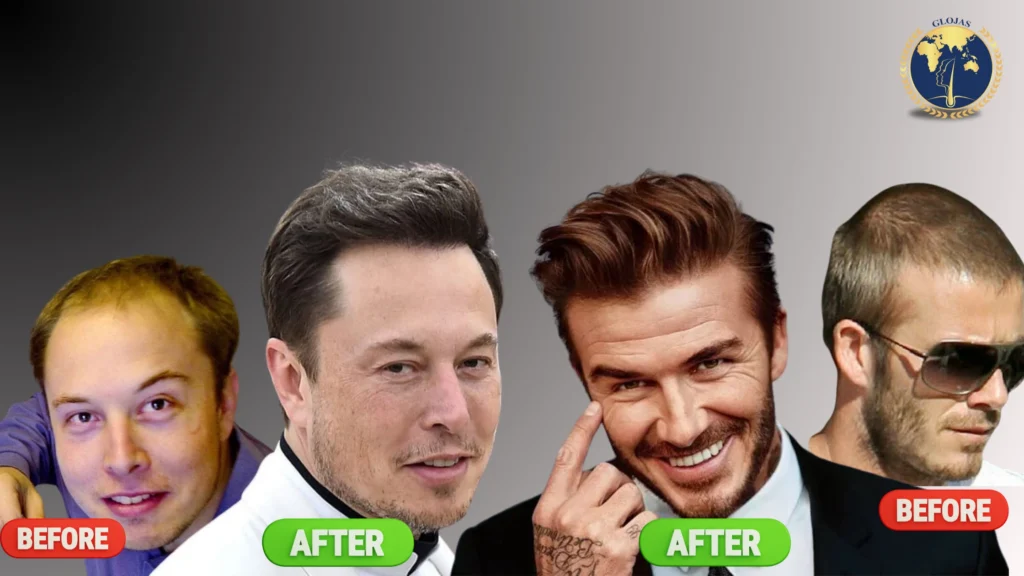
Happy to welcome you to the world of hair transplant! Here we going to discuss about the hair transplant hairstyles that most of the people worried about. It is not about you have already done hair transplant or not, it is about which hairstyle you should choose after a hair transplant. We also discuss about the celebrities who undergo hair transplant and how they maintain their hairstyle after that. Trends in Hair Transplant Hairstyles Hair Transplant Overview Hair Transplant is solution for most of the people with hair loss problem. In this generation, people no more using wigs as it not a permanent solution for the hair loss problem. Even though some companies selling products for stop hair loss, it might be not so effective. Thus, the only permanant solution for hair loss is undergoing hair transplant surgery. After Hair Transplant: Hairstyles In FUE hair transplant procedure, doctor will take individual hair follicles from the donor area. In most cases the donor area will be the back of the head (depends on type of hair loss). Then, the doctor move the hair follicles to the area which causes the hair loss. This procedure not only gives natural hair growth to people, but also gives more styling options for them: Celebrities and Hair Transplants Elon Musk’s Hair Transplant Journey Elon Musk, the CEO of Tesla and SpaceX, is often cited as a famous figure who has possibly benefited from hair transplantation. Observing his pictures from the early 2000s and comparing them to more recent ones, there’s a noticeable difference in his hair density and coverage. Musk’s transformation could be attributed to a strategic hair transplant, which now allows him more versatility with his hairstyles, frequently seen styled in shorter, well-groomed looks that complement his busy, public life. Insights on BTS V’s Hairline Transformation Kim Taehyung, popularly known as V from the global sensation BTS, has also sparked rumors of a possible hairline enhancement, reflecting the pressures of maintaining an ideal image in the spotlight. While there’s no official confirmation, fans and media speculate that V might have undergone a procedure to refine his hairline. This transformation allows him the freedom to experiment with various hairstyles, from sleek, pushed-back looks to playful, tousled waves, showcasing how hair transplants can significantly expand style possibilities while boosting confidence. Types of Hairstyles – Hair Transplant Hairstyles Embarking on the journey of a hair transplant is a significant step towards restoring confidence and revitalizing your appearance. After the procedure, as your new hair starts to grow, you may find yourself exploring various hairstyles to complement your transformed look. Whether you’re aiming for sophistication, versatility, or simplicity, here are some stylish options to consider: 1. The Classic Comb-over: A timeless choice, the comb-over is a versatile style that can be adapted to suit different hair lengths and textures. Simply comb your hair to one side, creating a sleek, polished look that exudes confidence and professionalism. 2. The Textured Crop: Embrace a contemporary vibe with a textured crop that adds depth and dimension to your hair. This style works well with shorter lengths, allowing you to experiment with subtle layers and tousled finishes for a effortlessly chic appearance. 3. The Slick Back: Achieve a sleek and sophisticated look by slicking back your hair. Whether you opt for a high-shine finish or a more matte texture, this refined style is perfect for formal occasions or making a statement in any setting. 4. The Buzz Cut: Embrace minimalism with a classic buzz cut that emphasizes clean lines and a no-fuss attitude. This low-maintenance style is ideal for those who prefer a streamlined look that requires minimal styling. Conclusion Embarking on a journey with a hair transplant can be a transformative experience not only for your appearance but also for your self-esteem. Choosing the right hairstyle post-transplant plays a pivotal role in enhancing the overall outcome. Whether you decide on a buzz cut to start with or grow your locks to experiment with different styles, what’s important is to take proper care of your new hair. Hair transplantation is a viable choice for people hoping to reestablish their hair and recapture their confidence. By grasping the various sorts of procedures, candidacy, preparation, and recovery processes, patients can make an educated decision about whether hair transplantation is appropriate for them. Consulting with a certified professional is fundamental to examine individual requirements and expectations and foster a customized treatment plan.
Pilihan Rawatan Kebotakan | Dapatkan Rawatan Terbaik di GLOJAS
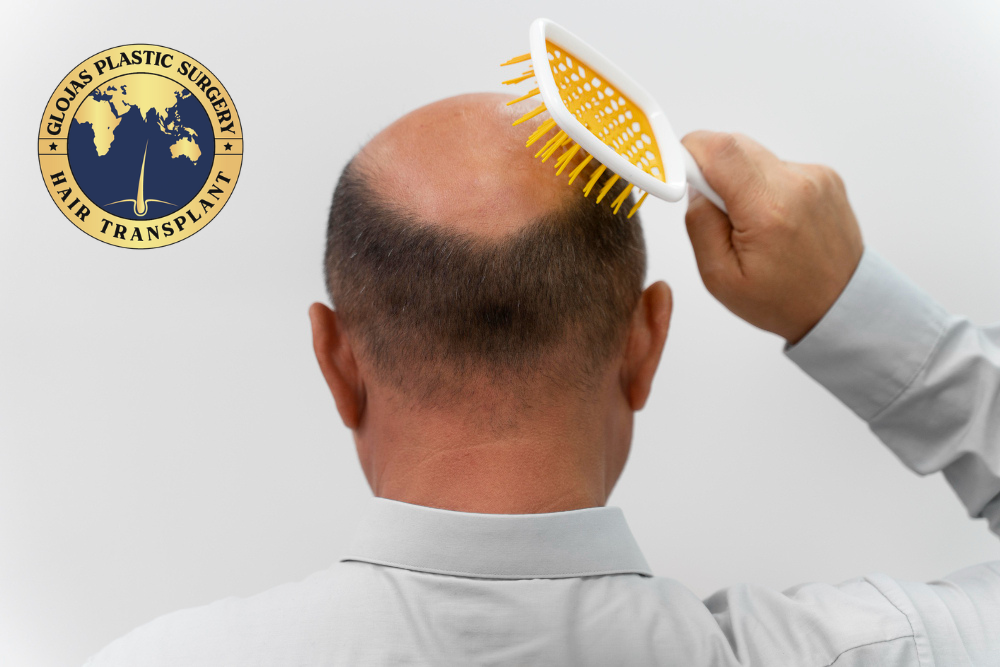
Kenali dahulu peringkat keguguran rambut anda Kebotakan corak lelaki atau keguguran rambut ditandai dengan penipisan rambut yang progresif di kepala, akhirnya membawa kepada kebotakan. Bagi kebanyakan lelaki, keguguran rambut bermula di kuil dengan garis rambut yang beransur surut. Rambut di ubun-ubun, atau belakang, kepala juga mungkin mula menipis.Corak rambut gugur ini biasanya dalam corak “M” dari dahi. Dalam kes yang teruk, tompok botak di atas mahkota akan bertemu di titik teratas dari semasa ke semasa, membentuk bentuk ladam kuda. Ini meninggalkan rambut hanya di bahagian belakang dan sisi kepala. Alamat : Glomac Galeria Hartamas, B-G, 05, Jalan 26a/70a, Desa Sri Hartamas, 50480 Wilayah Persekutuan, Wilayah Persekutuan Kuala Lumpur Dapatkan Arah Telefon : 012-989 1915 Laman Social : Facebook Youtube Instagram Pilihan Rawatan Kebotakan: Panduan Menangani Masalah Rambut Gugur 1. Rawatan Semulajadi– Minyak Rambut: Penggunaan minyak rambut khas boleh membantu menyuburkan akar rambut dan menggalakkan pertumbuhan yang sihat.– Penumbuh Rambut: Produk penumbuh rambut mengandungi bahan-bahan untuk merangsang pertumbuhan rambut baru. 2. Rawatan Oral– Suplemen Rambut: Suplemen yang mengandungi nutrien penting seperti biotin dan zink dapat membantu memperbaiki keadaan rambut.– Pil Rambut: Terdapat pil tertentu yang direka khas untuk merangsang pertumbuhan rambut. 3. Rawatan Klinikal– Terapi Laser: Penggunaan terapi laser low-level dapat meransang folikel rambut untuk meningkatkan pertumbuhan. 4. Rawatan Pembedahan– Penanaman Rambut: Kaedah terkini untuk kebotakan yang ketara melibatkan penanaman folikel rambut dari kawasan penderma ke kawasan rambut gugur. 5. Rawatan Alternatif– Terapi Akupunktur: Penggunaan jarum akupunktur pada titik tertentu di kepala untuk meransang pertumbuhan rambut.– Pengunaan Herba: Penggunaan ramuan herba tertentu seperti bawang putih atau daun lidah buaya untuk menggalakkan pertumbuhan rambut. 6. Rawatan DIY– Urutan Kulit Kepala: Urutan lembut kulit kepala boleh meningkatkan peredaran darah dan merangsang pertumbuhan rambut.– Bersukan: Kegiatan fizikal membantu mengurangkan tekanan dan meningkatkan kesihatan rambut. 7. Konsultasi Pakar– Doktor Rambut: Berbincang dengan doktor pakar rambut untuk mendapatkan nasihat dan rawatan yang bersesuaian.– Penasihat Kecantikan: Ahli kecantikan dapat memberikan panduan mengenai penjagaan rambut yang sesuai dengan keperluan kulit kepala dan rambut anda. Dapatkan Konsultasi Percuma Sekarang! Pakar Tanam Rambut di GLOJAS Your Trusted Board Certified Plastic Surgeon Specialist View this post on Instagram A post shared by GLOJAS HAIR TRANSPLANT SPECIALIST MALAYSIA (@fuehairtransplantmalaysia) Kebotakan boleh menjadi pengalaman yang memberikan tekanan kepada mental kita, tetapi dengan pilihan rawatan yang tersedia, individu yang mengalami masalah kebotakan boleh memilih mana2 rawatan yang bersesuaian dengan mereka.Penting untuk berbincang dengan doktor atau dermatologi yang berkelayakan untuk mendapatkan nasihat dan rawatan yang tepat berdasarkan keperluan dan keadaan individu. Di glojas, kumpulan pakar kami yang diketuai oleh Professor Dato` Dr JasG yang telah berpengalaman dan kemahiran lebih dari 26 tahun akan memastikan pelanggan kami berpuas hati. Dapatkan Konsultasi Percuma Sekarang! BACA ARTIKEL : Harga Tanam Rambut di Malaysia Facebook Twitter LinkedIn Pinterest Reddit WhatsApp